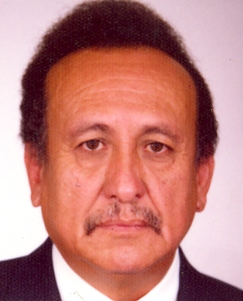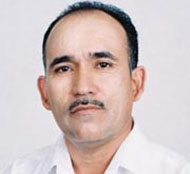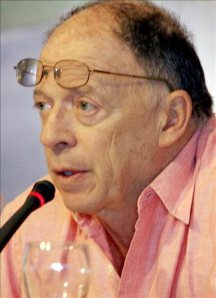Related Research Articles
Humberto Millán Salazar , a Mexican journalist, was a radio host of "Sin Ambages" on Radio Fórmula and the founder, editor, and columnist for the online newspaper A Discusión in Culiacan, Mexico. Salazar was abducted on 24 August 2011. His body was discovered by authorities the next day.
David Niño de Guzmán, a Bolivian journalist and editor, was chief editor for Fides News Agency (ANF) when he disappeared and was found dead two days later in the periphery of La Paz, Bolivia. While the cause of his death was an explosive device, the agency behind his death is suspicious and still disputed.
Medardo Flores, a radio journalist for Radio Uno in San Pedro Sula, was murdered in an ambush near his home in Puerto Cortes, Cortés Department, Honduras. A popular radio journalist, he was a supporter of former President Manuel Zelaya Rosales and joins other journalists killed since Zelaya was overthrown in the 2009 Honduran coup d'état.

José Antonio García Apac, also known as "El Chino", was a Mexican journalist and editor for the Ecos de la Cuenca in Tepalcatepec, Michoacán, Mexico, when he disappeared 20 November 2006. He is best known for the news stories he published on the violent relationship between the drug cartels in his home state and its authorities.
Marco Antonio Ávila Garcia,, a Mexican crime reporter for Diario Sonora de la Tarde in Ciudad Obregón and El Regional de Sonora newspapers in Sonora state, Mexico. He was abducted in Ciudad Obregón and tortured to death by a drug cartel and left on the side of the road near Empalme, which is also in Sonora. Garcia was the fifth journalist killed in 2012 in Mexico, which has become one of the most dangerous countries for journalists, and his murder preceded the 1 July 2012 Mexican elections, in which drug violence had become a major issue.

José Luis Romero, was a Mexican radio journalist for Línea Directa Radio and Radio Sistema del Noroeste in Los Mochis, Sinaloa, Mexico, and he was known for his reporting about drug trafficking. Romero was a journalist for roughly 20 years and had been with Línea Directa for ten years. He had been missing for two weeks until his body was found tortured and brutally murdered. Romero's murder, along with other Mexican journalists who have been killed during their job, was interpreted by CNN as intimidation toward journalists.
Raúl Gibb Guerrero was a Mexican editor and the founder and owner of the La Opinión in Poza Rica, Veracruz, Mexico. Gibb was murdered in Veracruz and was awarded "2005-2006 International Editors of the Year" by WorldPress.org. His newspaper had already won awards for his coverage of corruption.
Décio Sá was a Brazilian political journalist for O Estado do Maranhão and a blogger for Blog do Décio and at one time worked for Folha de S. Paulo. He was gunned down in a bar in São Luís, Maranhão, Brazil. Both the Committee to Protect Journalists and Reporters Without Borders confirmed, as well as police, that his death was related to his journalism.

José Bladimir Antuna Vázquez García, sometimes referred to only as Bladimir Antuna, was a Mexican crime journalist for El Tiempo de Durango, a newspaper based in Durango, Durango, Mexico. While there was a resolution in the case of Antuna's collaborator Eliseo Barrón Hernández, the murder case of Antuna is still unresolved and reflects the impunity that is widespread among murdered Mexican journalists.
Hernán Cruz Barnica was a Honduran journalist and activist who hosted a radio program in San Juan de Opoa, in western Honduras. He was murdered on May 28, 2014.
Nolberto Herrera Rodríguez was a Mexican journalist who worked for Channel 9 television in the state of Zacatecas. He was murdered on 29 July 2014. He was the fourth journalist to be murdered in Mexico in 2014 “in a possible or proven connection with their work.”
Luis de Jesús Lima was a Guatemalan radio journalist and personality for the Radio Sultana de Oriente in Zacapa, Zacapa Department, Guatemala. He was killed right outside of the station. His death focused the attention given to the safety of Guatemalan journalists.
Jorge Torres Palacios was a Mexican journalist and government spokesman who was murdered in 2014. At the time of his death he was a columnist for the Acapulco newspaper El Dictamen and for other local news media, including the website Libertad Guerrero Noticias. He was also a spokesman for the Acapulco municipal health department.
Rolando Ardani Santiz de León was a Guatemalan television journalist who was murdered in Guatemala City on April 1, 2009.

Armando Saldaña Morales,, was a Mexican radio journalist for the radio stations La Ke Buena and Radio Max in Tierra Blanca, Veracruz, Mexico. He was abducted on 2 May 2015 and found dead two days later 350 kilometers southeast of Mexico City near the town of Acatlan de Perez Figueroa, Oaxaca. He had been reporting about organized crime involvement in petroleum from Pemex, the Mexican oil company.
Murder of Danilo López and Federico Salazar is about the murders of two Guatemalan journalists that happened in Mazatenango Park, Mazatenango, located in the southern part of Suchitepéquez Department, Guatemala. Another journalist, Marvin Túnchez, was an injured victim of them same attack but survived. In the same area, camera operator Giovanni Guido Villatoro was killed in an unrelated crime just days after the deadly attack on the first three journalists.

Filadelfo Sánchez Sarmiento was a Mexican radio journalist and director for La Favorita 103.3 FM radio station in Miahuatlán de Porfirio Díaz, Oaxaca, Mexico. He was specifically targeted and fatally shot 5–7 times by two gunmen during a time of political discontent. The murder occurred around 9:30 am when Sarmiento walked from the local station after just finishing his morning news broadcast.

Jesús Adrián Rodríguez Samaniego was a Mexican radio journalist for the Antena 102.5 FM and a former crime reporter for the Organización Editorial Mexicana newspaper El Heraldo de Chihuahua, was murdered on December 10, 2016 in Chihuahua City, Chihuahua, Mexico. Reporters stated a possible motive for the murder may have been Rodríguez's investigation into the 2013 jailing of two brothers from the northern Mexican state of Sinaloa. This case was the 11th murder in Mexico of a journalist in 2016, the year with the highest number recorded.

Orlando Sierra Hernández was a Colombian columnist and deputy director for La Patria newspaper in the capital of the Department of Caldas, Manizales, Colombia. He wrote a column and regularly criticized the corruption of the Colombian government. He was also a novelist and poet.

The disappearance of Alfredo Jiménez Mota is about the 25-year-old Mexican journalist, working for El Imparcial (Hermosillo) in the northern city of Hermosillo, Sonora, Mexico, who went missing while investigating government involvement with organized crime and drug traffickers in Sinaloa during the Mexican Drug War. Journalist José Reveles reported in his book, El cártel incómodo: El fin de los Beltrán Leyva y la hegemonía del Chapo Guzmán, that Raúl Gutiérrez Parra, who was also later killed, ordered Los Güeros to murder Jiménez Mota as his investigations interfered with the flow of drugs through Sinaloa.
References
- 1 2 3 "Director-General condemns murder of Guatemalan journalist Marco Antonio Estrada". UNESCO. Jun 18, 2009.
- 1 2 3 "Marco Antonio Estrada". Committee to Protect Journalists.
- 1 2 "Asesinado el segundo periodista en lo que va del año". Reporters without Borders. Jun 9, 2009. Archived from the original on March 4, 2016. Retrieved October 30, 2014.
- ↑ "SIP condena el asesinato a tiros de periodista guatemalteco". El Confidencial. Jun 8, 2009.